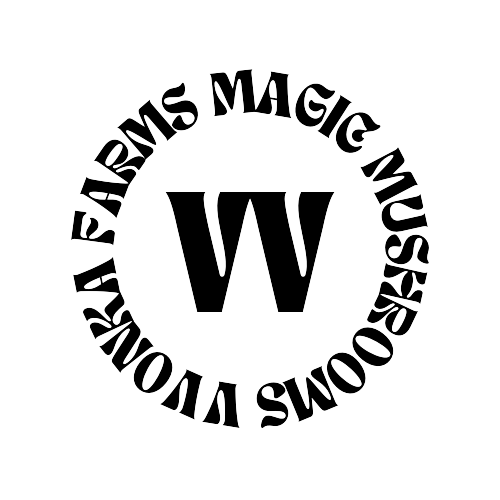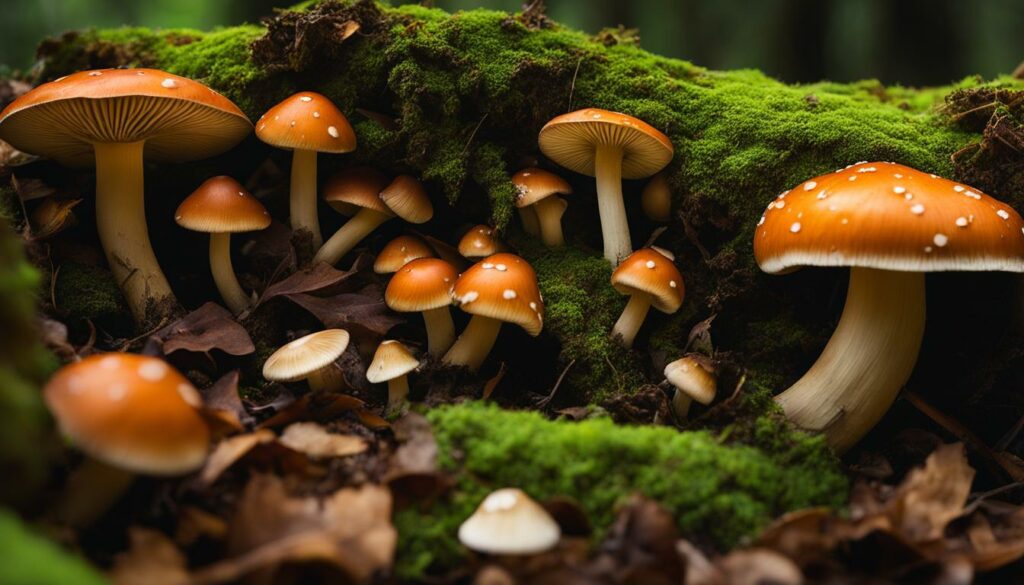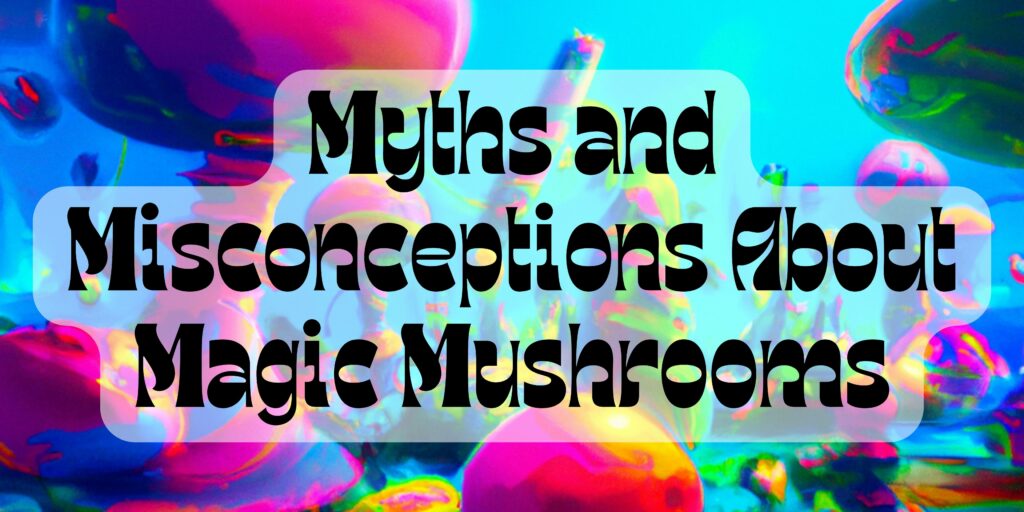Welcome to your ultimate guide on identifying edible mushrooms safely! Whether you’re an avid mushroom forager or a beginner looking to explore the world of edible shrooms, it’s important to know how to identify them safely. In this guide, we’ll provide you with essential tips and tricks to help you distinguish edible mushrooms from their potentially poisonous counterparts.
Identifying edible mushrooms can be a rewarding and delicious experience, but it requires careful attention to detail. By understanding the key characteristics to look for and following proper identification techniques, you can confidently enjoy the bounty of nature’s edible treasures.
Key Takeaways:
- Knowing how to identify edible mushrooms is essential for safe foraging.
- Avoid mushrooms with white gills, red caps or stems, scaly spots, and a ring around the stem.
- Consult an expert or join a mycological group for assistance in identifying uncertain mushrooms.
- Always err on the side of caution and do not consume a mushroom unless you are 100% sure of its identity.
- Proper research, field guides, and foraging precautions are crucial for a safe and enjoyable mushroom-hunting experience.
How to Safely Forage for Edible Mushrooms
When it comes to foraging for edible mushrooms, following safety guidelines is essential. Here are some tips to help you safely enjoy the experience:
- Carry two baskets: One basket should be for mushrooms that you are confident are edible, while the other should be for mushrooms you are unsure about. This way, you can avoid ingesting potentially poisonous mushrooms.
- Seek guidance from experts: Look for local mycological groups or consider joining a mushroom expert on a foray. These experienced individuals can provide valuable knowledge about safe mushroom foraging and help you identify different species.
- Invest in resources: Purchase a mushroom field guide specific to your region. This will assist you in identifying different mushroom varieties and understanding their characteristics. Additionally, consider attending mycology classes offered by local universities if available.
By taking these precautions and arming yourself with knowledge, you can explore the world of edible mushrooms with confidence and ensure a safe foraging experience.
Table: Essential Foraging Tools
| Tool | Description |
|---|---|
| Basket or bag | A container to hold the mushrooms you collect while foraging. |
| Knife | A sharp knife for cleanly cutting mushrooms from their base. |
| Field guide | A comprehensive guidebook with detailed information about mushroom identification. |
| Hand lens | A magnifying lens to examine the fine details of mushrooms. |
| Foraging bag | A bag to store any additional foraging tools or personal belongings. |
Remember, foraging for mushrooms can be a rewarding and enjoyable activity, but it’s crucial to prioritize safety and ensure proper identification before consuming any mushroom.
Quote: “The key to safe mushroom foraging lies in education and expert guidance.” – Mushroom Expert
By following the tips provided and seeking knowledge from experts, you can confidently embark on your mushroom foraging adventures and discover the wonders of the fungal world.
Popular Edible Mushroom Varieties and How to Identify Them
When it comes to foraging for edible mushrooms, it’s important to be able to identify the different varieties that can be safely consumed. Here, we will explore some of the most popular edible mushroom species and their key characteristics for easy identification.
Porcini Mushrooms (Boletus edulis)
Porcini mushrooms are highly prized for their rich flavor and meaty texture. They have a medium-sized tan or brown cap with a smooth surface and a thick bulbous stem. One distinctive feature of porcini mushrooms is their spongy undersides, known as pores, instead of gills.
Chanterelles
Chanterelles are known for their delicate and fruity aroma. They have a small cap with a concave center and a trumpet-shaped stalk. The cap ranges in color from pale yellow to deep orange, and it has a distinct ridged and wrinkled appearance.
Puffballs
Puffballs are unique mushrooms that have a globe-shaped cap and no visible stem. Their cap is white or pale tan and is covered in densely packed spines. Puffballs can grow to be quite large and have a spongy texture when cut open.
Shaggy Mane Mushrooms
Shaggy mane mushrooms, also known as coprinus comatus, have a tall, column-like cap with flaky shingles. They are characterized by their white color and long, slender stems. One interesting feature of shaggy mane mushrooms is that they have gills that turn black and liquify as the mushroom matures.
| Edible Mushroom Variety | Scientific Name | Characteristics |
|---|---|---|
| Porcini Mushrooms | Boletus edulis | Medium-sized tan or brown cap, thick bulbous stem, spongy pores |
| Chanterelles | Cantharellus | Small cap with a concave center, trumpet-shaped stalk, ridged and wrinkled appearance |
| Puffballs | Lycoperdon | Globe-shaped cap, no visible stem, densely packed spines |
| Shaggy Mane Mushrooms | Coprinus comatus | Tall, column-like cap with flaky shingles, white color, long, slender stems, gills that turn black and liquify |
These are just a few examples of popular edible mushrooms that can be safely foraged and enjoyed. Remember, always consult a reliable mushroom identification guide or expert to ensure proper identification before consuming any wild mushrooms.
The Chemical Constituents in Magic Mushrooms
When it comes to magic mushrooms, the key components responsible for their psychedelic effects are psilocybin and psilocin. These compounds mimic endogenous serotonin in the brain and interact with the 5-HT2A receptor. This interaction leads to changes in mood regulation and sensory perception, resulting in the psychedelic experience. Magic mushrooms also contain other chemical constituents, such as baeocystin and aeruginascin, which may contribute to their effects. Ongoing research is exploring the therapeutic potential of magic mushrooms for conditions like depression, PTSD, and OCD.
“The chemical compounds found in magic mushrooms have the ability to profoundly alter one’s perception and consciousness. The effects can vary from person to person, but they often include visual hallucinations, intensified emotions, and a heightened sense of connection to the world around them.”
Psilocybin and Psilocin
Psilocybin is a prodrug that is converted to psilocin after ingestion. Both psilocybin and psilocin are classified as Schedule I substances due to their psychoactive properties. Psilocin is the primary compound responsible for the psychedelic effects, as it is able to cross the blood-brain barrier and directly interact with serotonin receptors in the brain.
Therapeutic Potential
The therapeutic potential of magic mushrooms is increasingly recognized and studied. Research suggests that the use of psilocybin-assisted therapy may be beneficial in treating mental health conditions, such as depression and anxiety. Psilocybin has been shown to promote neuroplasticity and enhance the formation of new neural connections, leading to long-lasting improvements in mood and well-being. However, it is important to note that the therapeutic use of magic mushrooms should always be conducted under the guidance of trained professionals in a controlled and supportive environment.
| Chemical Compound | Effects |
|---|---|
| Psilocybin | Psychedelic experience, altered perception, intensified emotions |
| Psilocin | Psychedelic experience, altered perception, intensified emotions |
| Baeocystin | Potential contribution to psychedelic effects |
| Aeruginascin | Potential contribution to psychedelic effects |
While magic mushrooms have been used for centuries for spiritual and recreational purposes, it is crucial to approach their use with caution and respect. They should only be consumed in a safe and controlled environment, with careful consideration of dosage and set and setting. The future of psychedelic research holds promise for a better understanding of the therapeutic potential of magic mushrooms and their potential to improve mental health and well-being.
Where Do Psychedelic Mushrooms Grow?
Psychedelic mushrooms, also known as magic mushrooms or psilocybin mushrooms, thrive in specific habitats and growing conditions. Understanding their preferred environments is crucial for those interested in foraging or cultivating these unique species.
Psilocybin-containing mushrooms can be found in various parts of the world, but they tend to favor cool to warm and damp climates with high humidity. These mushrooms are often found in moist, shaded areas such as forests, grasslands, and fields. They have a preference for growing on decaying organic matter, including trees, logs, the forest floor, or even moss-covered surfaces.
One important factor to consider is that psychedelic mushrooms often form symbiotic mycorrhizal associations with certain trees and plants. This means they have a mutually beneficial relationship with their host, allowing them to access essential nutrients. Some examples of such associations include psilocybin mushrooms growing in conjunction with oak, pine, or birch trees.
Table: Examples of Ideal Mushroom Environments
| Mushroom Species | Preferred Habitat |
|---|---|
| Psilocybe cubensis | Tropical and subtropical regions, cow pastures, wood chips |
| Panaeolus cyanescens | Grasslands, manure-enriched soils |
| Copelandia cyanescens | Coastal areas, sandy soils |
| Psilocybe semilanceata | Grassy meadows, pastures |
It’s worth noting that the presence of psychedelic mushrooms can vary depending on the season and local climate. The best time to find them is usually during the rainy season or after heavy rainfall, as the moisture stimulates their growth.
Remember, if you’re interested in foraging psychedelic mushrooms, always prioritize safety and legality. Familiarize yourself with local laws and regulations, and consult experienced mycologists or mushroom experts to ensure proper identification and understanding of the potential risks associated with psychedelic mushroom foraging.
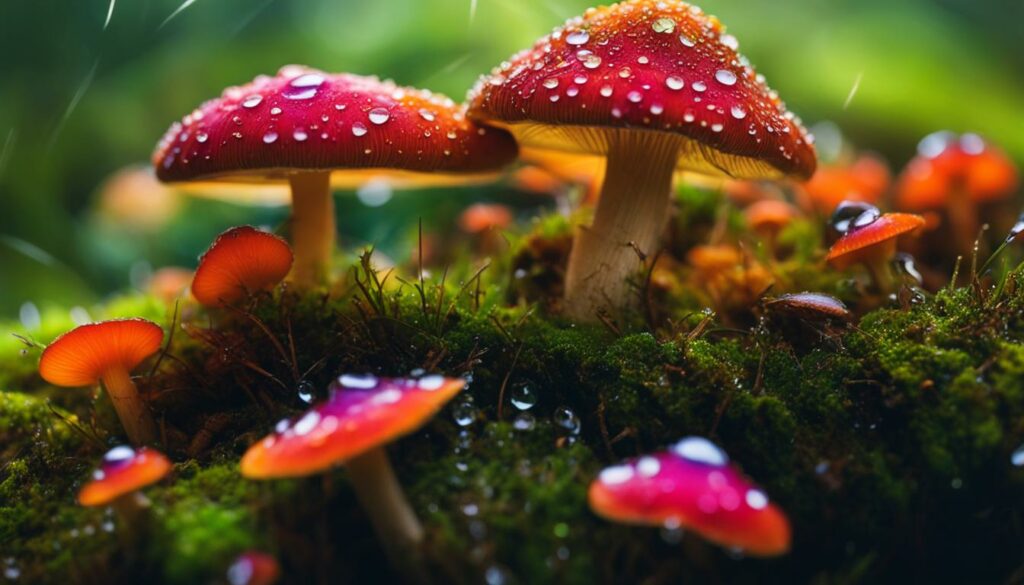
Identifying the Most Common Psilocybe Mushrooms
Psilocybe mushrooms, also known as “magic mushrooms,” are a group of psychoactive fungi that contain the compound psilocybin. There are several Psilocybe species that are commonly encountered and sought after for their psychedelic effects. In this section, we will explore some of the most common Psilocybe mushrooms and discuss how to identify them.
One of the most widespread and well-known Psilocybe mushrooms is Psilocybe cubensis, often referred to as “Golden Teachers.” These mushrooms have a distinctive appearance with a light to dark brown cap, often with a slightly convex shape. The caps can range in size from small to large, and they have a smooth texture. The gills of Psilocybe cubensis are typically dark purplish-brown when mature.
Another common Psilocybe species is Psilocybe semilanceata, also known as “Liberty Caps.” These mushrooms are usually small in size, with a distinctive conical cap that has a nipple-like protrusion at the center. The caps can range in color from light brown to a reddish-brown hue. Liberty Caps often grow in grassy areas or meadows, and they are known for their potent psychedelic effects.
Psilocybe cyanescens, also referred to as “Wavy Caps,” is another commonly encountered Psilocybe species. These mushrooms have wavy caps with a dark brown to caramel coloration. They are typically found growing on wood chips or decaying wood in urban areas. Wavy Caps are known for their high psilocybin content and are sought after by experienced psychonauts.
| Psilocybe Mushroom | Appearance | Habitat |
|---|---|---|
| Psilocybe cubensis | Light to dark brown cap, smooth texture | Grows in various habitats, including grassy areas and forests |
| Psilocybe semilanceata | Conical cap with a nipple-like protrusion, light to reddish-brown color | Grows in grassy areas, meadows, and fields |
| Psilocybe cyanescens | Wavy cap, dark brown to caramel color | Grows on wood chips and decaying wood in urban areas |
Please note that the identification of Psilocybe mushrooms should be done with caution and expertise. Some Psilocybe species can closely resemble toxic look-alikes, making accurate identification crucial for safety. It’s always recommended to consult with experienced mycologists or join local mycological groups for guidance when seeking and identifying Psilocybe mushrooms.
By familiarizing yourself with the characteristics of the most common Psilocybe mushrooms and seeking expert advice, you can enhance your ability to identify these psychoactive fungi safely and responsibly.
Tips for Safely Identifying and Foraging Edible Mushrooms
When it comes to identifying and foraging for edible mushrooms, safety should always be a top priority. To ensure a safe and successful mushroom foraging experience, follow these expert tips and precautions:
1. Start with Beginner-Friendly Mushrooms
If you’re new to mushroom foraging, it’s best to start with mushrooms that are easy to identify and have few toxic look-alikes. Some beginner-friendly options include chanterelles, morels, and porcini mushrooms. Familiarize yourself with their unique characteristics, such as color, shape, and smell, to confidently identify them in the wild.
2. Research and Study Mushroom Characteristics
Prior to heading out for a foraging adventure, take the time to research and study the specific characteristics of the mushrooms you’re interested in. Use a reliable field guide or consult expert resources to learn about their distinct features, growth habits, and potential toxic look-alikes. This knowledge will help you make informed decisions and avoid consuming poisonous varieties.
3. Pay Attention to Key Indicators
When identifying mushrooms, pay close attention to factors such as color, shape, texture, smell, and taste. These key indicators can provide valuable insights into the identity and edibility of a mushroom. For example, some poisonous mushrooms have distinctively bright colors or emit a foul odor, while edible varieties may have a pleasant aroma and mild flavor. Trust your instincts and err on the side of caution if you’re unsure about a particular mushroom.
4. Cook All Wild Mushrooms Before Consumption
To ensure safety, it’s important to cook all wild mushrooms before consuming them. Cooking mushrooms helps break down potentially harmful compounds and makes them more digestible. Whether you plan to sauté, grill, or incorporate them into your favorite recipes, be sure to thoroughly cook mushrooms to eliminate any potential risks.
By following these safe mushroom identification and foraging tips, you can enjoy the thrill of hunting for edible mushrooms while minimizing the risks. Remember, learning from knowledgeable experts and always double-checking your identifications are crucial steps in ensuring a successful and safe mushroom foraging experience.
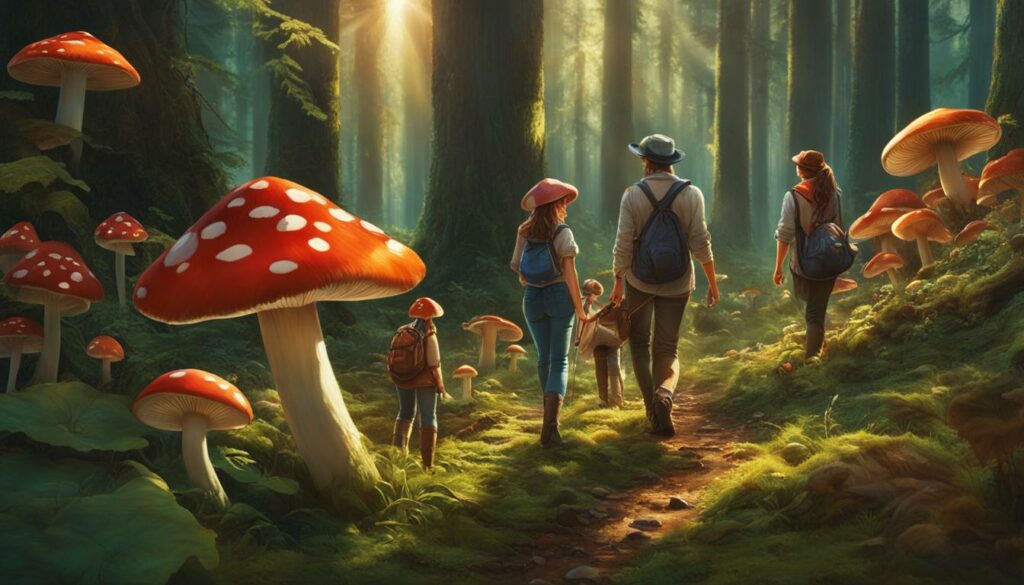
Conclusion
In conclusion, understanding mushroom identification and foraging safety is essential for both culinary enthusiasts and those interested in psychedelic mushrooms. By familiarizing yourself with the characteristics of different edible mushroom species and seeking guidance from experts or reliable resources, you can confidently identify and enjoy a variety of edible mushrooms. Remember to prioritize safety by following best practices, such as carrying separate baskets for mushrooms you are confident are edible and those you are unsure about.
Foraging for mushrooms can be an exciting and rewarding experience, but it’s crucial to exercise caution. Always cook wild mushrooms before consumption, start with small amounts to test for adverse reactions, and trust your instincts when in doubt. When it comes to psychedelic mushrooms, it’s important to research and understand the specific strains you’re interested in and to be aware of any legal implications surrounding their use in your location.
Whether you’re searching for the perfect ingredient for your next culinary masterpiece or exploring the fascinating world of psychedelic mushrooms, remember to prioritize safety and follow the best practices outlined in this guide. With the right knowledge and precautions, you can confidently navigate the realm of edible mushrooms, appreciate their unique flavors, and potentially uncover the extraordinary properties of psychedelic varieties. Happy foraging and mushroom exploration!
FAQ
What are the key characteristics to look for when identifying edible mushrooms?
Avoid mushrooms with white gills, red on the cap or stem, scales on the cap, or a ring around the stem. Consult an expert or join a mycological group for assistance in identifying mushrooms.
What precautions should I take when foraging for edible mushrooms?
Carry two baskets – one for mushrooms you are confident are edible and another for mushrooms you aren’t sure about. Seek out local mycological groups or join a mushroom expert on a foray. Buy a mushroom field guide and attend mycology classes if available.
What are some popular edible mushroom varieties and how can I identify them?
Porcini mushrooms have a tan or brown cap and a thick stem. Chanterelles have a small cap with a concave center and a trumpet-shaped stalk. Puffballs have a globe-shaped white or pale tan cap with densely packed spines. Shags have a tall, column-like cap with flaky shingles and blade-like gills.
What chemical compounds are found in magic mushrooms and what do they do?
Magic mushrooms contain psilocybin and psilocin, which mimic serotonin in the brain and interact with the 5-HT2A receptor, leading to changes in mood and sensory perception. Other compounds such as baeocystin and aeruginascin may also contribute to their effects.
Where do psychedelic mushrooms typically grow?
Psychedelic mushrooms favor cool to warm and damp climates with high humidity. They can be found in moist, shaded areas such as forests, grasslands, and fields. They often form symbiotic associations with certain trees and plants.
What are some common psilocybe mushrooms and how can I identify them?
Psilocybe cubensis, or “Golden Teachers,” have a medium-sized cap and thick stem. Psilocybe semilanceata, or “Liberty Caps,” have a distinctive conical cap with a nipple-like protrusion. Psilocybe mexicana, or “Teonanácatl,” have a yellow to brown cap and a conical shape. Psilocybe cyanescens, or “Wavy Caps,” have wavy caps and thicker stalks.
What are some tips for safely identifying and foraging for edible mushrooms?
Start with beginner-friendly mushrooms that are easy to identify and have few toxic look-alikes. Research and study specific mushroom characteristics. Consult a field guide or expert resources. Cook all wild mushrooms before consumption and start with small amounts to test for adverse reactions. Trust your instincts and don’t consume a mushroom unless you’re 100% sure of its identity.
How can I safely identify and enjoy edible mushrooms?
By understanding mushroom characteristics, consulting experts or reliable resources, and practicing safe foraging techniques, you can confidently identify and harvest edible mushrooms. Prioritize safety, follow best practices, and enjoy their unique flavors and potential benefits.
